Thunderbolt 3 in Action: Akitio Thunder3 Duo Pro DAS Review
by Ganesh T S on April 14, 2016 8:30 AM EST- Posted in
- Storage
- DAS
- Thunderbolt 3
- Akitio
The Nuts and Bolts of Thunderbolt 3
In order to understand and appreciate Thunderbolt 3, it is important to look at how Thunderbolt has evolved over the last five years. Thunderbolt was launched in 2011 to provide a unified interface with enough bandwidth to satisfy virtually everything needed simultaneously in terms of external I/O and display output. The first two versions shared the same cabling and connectors as mini-DisplayPort. They essentially muxed / demuxed PCIe lanes and DisplayPort lanes over a Thunderbolt cable using Thunderbolt controllers.
At the time of its launch, Thunderbolt was facing competition from USB 3.0 which had already seen a lot of adoption on the PC side. The parallels between USB 2.0 / FireWire and USB 3.0 / Thunderbolt were difficult to ignore. Even after Thunderbolt 2 was launched (with the ability to aggregate the two discrete bidirectional 10Gbps channels in the first version of Thunderbolt), the perception remained that it was relevant only to Mac users. Despite a number of PC components with Thunderbolt 2 integrated, Windows users never found the technology to live up to its advertised potential. Common complaints included peripherals not carrying certification for use on PCs, peripherals outright not working on PCs, unreliable hot-plugging and degraded performance compared to what one could obtain with the same device in a Mac.
In 2012, Intel luanched an Ivy Bridge NUC with Thunderbolt integrated. Unfortunately, the issues cited above resulted in Thunderbolt getting completely dropped from the NUC lineup. It was a golden chance for Intel to drive up Thunderbolt adoption, but, the overall peripheral market put a spanner in the works.
Thunderbolt 3 and Type-C
While the 'Thunderbolt for PCs' market was trying to build momentum, USB-IF started to finalize the specifications for USB 3.1 that could deliver up to 10 Gbps of theoretical bandwidth. By mid-2015, the USB consortium had announced both 10Gbps “Superspeed+” USB 3.1 Gen 2 and the new USB Type-C connector, a compact, reversible connector designed to drive the standard for the next decade or more. The introduction of USB Alternate Mode functionality – the ability for USB Type-C to carry other protocols along with (or instead of) USB Superspeed data – made USB more flexible than ever. VESA had also announced that DisplayPort would be supporting alternate mode to deliver DisplayPort video over USB Type-C ports and cables.
At Computex 2015, Intel announced Thunderbolt 3. It marked a shift in the signaling layer from what was used in Thunderbolt 1 and Thunderbolt 2. This was done in order to support more bandwidth per cable. By taking advantage of USB Type-C's alternate modes (i.e, the four high-speed data lanes in the Type-C specifications), Thunderbolt 3 became a standard built on top of the USB Type-C port.
Along with the change in the cable and connectors, Thunderbolt 3 also upgraded the total available bandwidth to 40 Gbps. Thunderbolt 3 also updated the active cables with electronics at both cable ends to support full bandwidth. With the usual Type-C cables, Thunderbolt 3 drops down to 20 Gbps.
Intel also markets Thunderbolt as the 'Type-C that does it all'. It is easy to see the reason behind this.
Consumers should always check the logo next to their Type-C port in order to identify the capabilities of the port in terms of the bandwidth available, power delivery capability and DisplayPort carriage support. Intel wants to bring it across to consumers that the Thunderbolt logo encompasses all these capabilities. Readers might wonder where the USB 3.1 capabilities suggested above come from. This is where the Alpine Ridge controller comes into the picture.
The Alpine Ridge Controller
Intel's chipsets usually take a generation or two after the introduction of any I/O version update (say, SATA II to SATA III, or, USB 2.0 to USB 3.0) before getting native support for the latest version. In the meanwhile, motherboard vendors resort to third-party bridge chips that interface with the PCH using PCIe lanes to provide the latest and greatest I/Os. The same thing is happening currently with USB 3.1, and this is where Intel has found a way to sneak in Thunderbolt support into more systems.
Intel's Thunderbolt 3 controller (Alpine Ridge) also integrates its own USB 3.1 (Superspeed+) host controller, which in turn serves dual purposes. When serving as a host controller for a USB Type-C port, this allows Alpine Ridge to directly drive USB 3.1 device if they’re plugged into an Alpine Ridge-backed Type-C port (similar to how DisplayPort works today with Thunderbolt ports). And when serving as a device controller (e.g. in a Thunderbolt monitor), this allows devices to utilize and/or offer USB 3.1 ports on their end.
Given that motherboard vendors integrate a USB 3.1 Gen 2 bridge chip in most mid-range and higher products, it actually costs them only a slight premium to go in for Alpine Ridge as compared to, say, an ASMedia bridge chip which can only provide USB 3.1 Gen 2 functionality.
Thunderbolt 3 Usage Scenarios
Thunderbolt 3 enables various scenarios such as a single-cable docking solution for charging, data transfer and display output, and external discrete GPU docks with hot-plug support.
Thunderbolt Networking also allows creation of a 10 Gbps network for peer-to-peer connection between various computing systems (based on a network adapter model in the host OS).
Given Intel's lofty goals with Thunderbolt 3, and the fact that systems with the ability to act as Thunderbolt 3 hosts have been shipping since late last year, it was imperative that various Thunderbolt 3 products enabling the above usage scenarios had to come to the market soon. The credit for being the first shipping Thunderbolt 3 peripheral goes to the Akitio Thunder3 Duo Pro. Intel and Akitio shipped us a couple of units so that we could check out the capabilities of Thunderbolt 3 in practical scenarios.



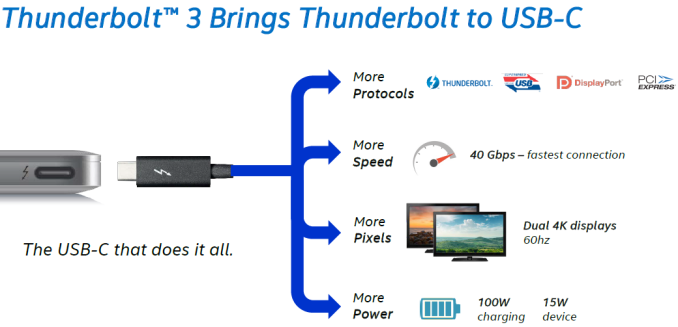
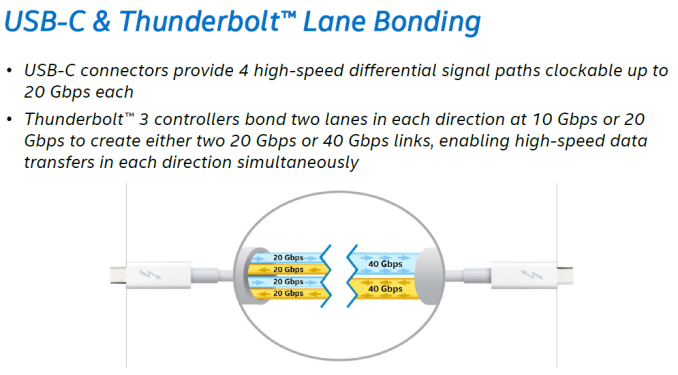
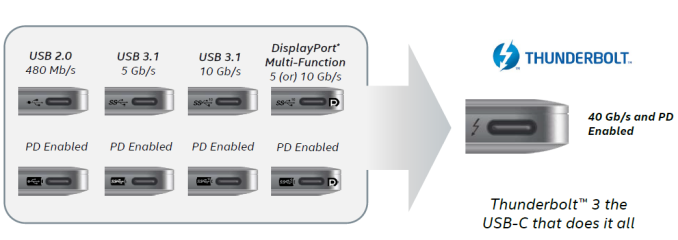
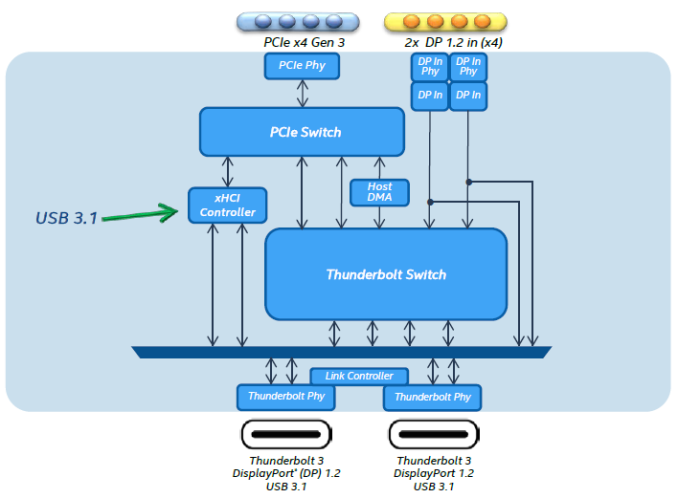
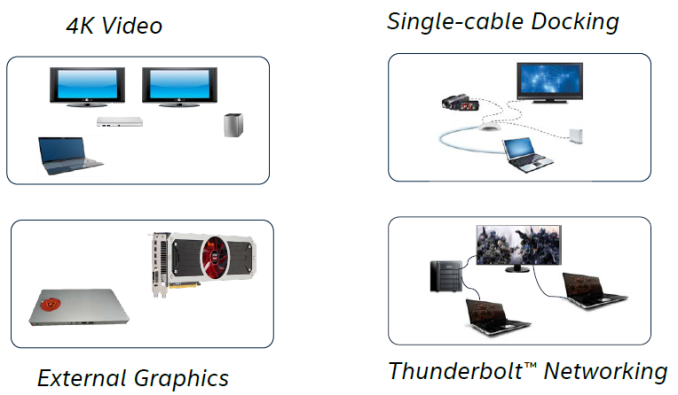








60 Comments
View All Comments
name99 - Thursday, April 14, 2016 - link
I don't understand this obsession with daisy-chaining. Daisy-chaining is a LOUSY technology. It's been a lousy technology in every damn form it's ever shipped, whether SCSI, ADB, firewire, or thunderbolt. One of the few things USB actually got right from the start was to make it clear on day one that their expansion solution was hubs, not daisy-chaining.Why does it suck?
- It substantially reduces your power-on-off flexibility. This may not matter in a testing lab, but in the real world there are constant reasons why you might want to power a device off. With a hub this is a simple issue; with a daisy-chain it requires considering the implications of everything that is connected, and generally unmounting a bunch of devices then changing the topology.
- right now when it's all skittles and roses, every thunderbolt device comes with two ports. But as soon as this goes mainstream, the usual attempts at cost-cutting will have one device after another shipping with only one port. And then what happens to your chaining?
Because USB got this right on day one, USB hubs have always been cheap as dirt. Everybody owns one, and devices that need to present the illusion of daisy-chaining (like keyboards with two USB ports, one for the mouse to connect to; or displays with USB connectors) just stick in a cheap USB hub chip. Because Firewire (and the other specs I mentioned) did NOT get this right, FW hubs never became cheap. Even the FW400 hubs were expensive, and I don't think decent FW800 hubs were EVER produced (when I was looking for them, the best I could find was a pathetic two port hub).
Instead of cheering how great Thunderbolt daisy-chaining is, you should be considering the reality that, because Intel has insisted on doing things this way (in spite of THIRTY YEARS of evidence that it is a stupid idea) they are likely going to snatch defeat from the jaws of victory. All those thunderbolt-enabled USB C ports will ACTUALLY land up connected to pure USB3.1 hubs, which will in turn, once again, mean that USB3.1 is the only really viable mass market for storage, and these super-high-end storage solutions (and external GPUs, etc) will continue to remain irrelevant to the mass market.
Nice going Intel --- turns out instruction sets are not the only things you're incapable of handling competently.
Klug4Pres - Friday, April 15, 2016 - link
Enjoyable rant, thanks!Wardrop - Friday, April 15, 2016 - link
I'm sure Apple, who are obsessed with having a single cable for everything, would have been the ones who pushed Intel to support daisy chaining.Daisy chaining isn't a bad idea if implemented properly though. It should be passive to really work, as in, a physically unplugged device should be able to pass through a thunderbolt signal. Like a switch that opens and closes depending on whether the device is powered on or not.
galta - Friday, April 15, 2016 - link
A little bit angrier than I would have expected, but correct in its essence.All these weird proprietary interfaces fail for a combination of high costs and lack of scale. All of us - or at least most of us - remember when microchannel was thought to be the future and we all know were it ended.
As someone said before, Thunderbolt, as well as FireWire in its time, will make sense only for the 15 people who make 4k video editing on a 5k monitor on their Apples.
The remaining will be more than glad to remain with USB.
zodiacfml - Friday, April 15, 2016 - link
Same here. I never understood daisy chaining. I just dismissed it long ago that some people use the feature.ganeshts - Friday, April 15, 2016 - link
Daisy chaining is a feature that is available.It is not mandatory that it needs to be used.
Most people can just use a dock and it would have all the types of USB 3.x ports that they need.
The beauty of Thunderbolt 3 is that it allows for just a single interface in sleek products, and it will have an ecosystem that allows people to pick and choose what interfaces they want in their system when 'docked' - that can't be said for proprietary interfaces developed by system vendors. (though I do agree that Thunderbolt being restricted to Intel-only systems is a bit of an issue in the long run - if AMD manages to claw back to performance parity with mid-range and higher Intel systems)
hyno111 - Friday, April 15, 2016 - link
The ATTO and CrystalDiskMark result for SSD RAID is missing.ganeshts - Friday, April 15, 2016 - link
My apologies. There was a CMS issue when we updated the HDD results. It is now fixed.epobirs - Saturday, April 16, 2016 - link
Considering the main bottleneck here is going to be SATA, it seems like the box could have been implemented with USB 3.1 Gen 2 and delivered the same performance at lower cost. Even with two SSDs rather than platter drives, the best throughput after overhead should rarely exceed what USB 3.1 can handle.Down the road, a box with slots for, say, four U.2 SSDs, should really utilize Thunderbolt 3's bandwidth while still being small enough to consider portable. THAT would be worth spending a good amount for a professional user, being able to access live data or do very large backups at those speeds in a rig small enough to go on a location shoot comfortably.
ganeshts - Saturday, April 16, 2016 - link
Definitely.. the performance of a single unit is very close to that of the bus-powered SanDisk Extreme 900 we reviewed before. However, this unit is clearly meant to introduce the benefits of Thunderbolt 3 to the market - DisplayPort output, daisy chaining with docks for extra functionality etc. The storage bandwidth from a single unit is not the main focus, as this is one of the first Thunderbolt 3 devices to be introduced. We will soon see high bay-count devices with Thunderbolt 3 at NAB next week - Accusys has already pre-announced a 12-bay one.